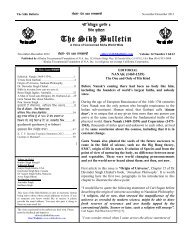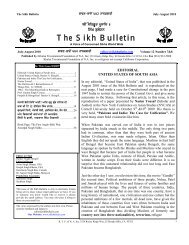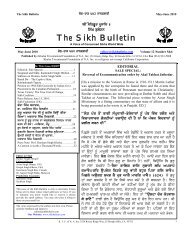Selected Editorials - The Sikh Bulletin
Selected Editorials - The Sikh Bulletin
Selected Editorials - The Sikh Bulletin
You also want an ePaper? Increase the reach of your titles
YUMPU automatically turns print PDFs into web optimized ePapers that Google loves.
P. 13 “Of the four (Janamsakhis) the least reliable is the Bala tradition, but its influence has been<br />
immense.”<br />
Immense, indeed; this Bala was a fiction, his image, along with Guru Nanak’s and Mardana’s above the<br />
entrance to Darbar Sahib notwithstanding. It was this Janamsakhi that turned me off from <strong>Sikh</strong>i even<br />
before my teenage years. Having received my elementary and middle school education through Hindi<br />
medium in the former Bikaner State, I learnt Panjabi at home by reading books like ‘Bale dian sakhian’. I<br />
did not believe a single karamaat ascribed to Guru Nanak and to me Guru Nanak became just another<br />
mythical Hindu Devta that I had read about in Hindu granths. Dr. McLeod should have debunked this<br />
Janamsakhi completely.<br />
P. 39 “In response to Mardana’s inquiry concerning the inequalities of the human condition Baba Nanak<br />
replied, ‘joy and pain come in accordance with the deeds of one’s previous existence’.” (From Puratan<br />
Janamsakhi)<br />
<strong>Sikh</strong>ism does not subscribe to the Hindu concept of previous life which is an excuse for the caste system<br />
that Guru Nanak condemned.<br />
But Dr. McLeod is not quoting from the various Janamsakhis to elaborate on Guru Nanak’s philosophy.<br />
After devoting pp. 34-110 to the details in Janamsakhis, he concludes:<br />
P. 111 About Guru’s visit to Assam, “It must, however, be both challenged and rejected”.<br />
P. 112 About Guru’s visit to Dacca, “<strong>The</strong> tradition must, however, be summarily dismissed”.<br />
P. 117 About Guru’s visit to Ceylon, “<strong>The</strong> tradition that Guru Nanak visited Ceylon must accordingly be<br />
rejected”.<br />
P. 119 Guru’s encounter with Sajjan Thag, “As it stands, however, it must be classified with the<br />
improbable sakhis”.<br />
P. 120 <strong>The</strong> discourse on Mount Sumeru, “In this case, however, the arguments which must be brought<br />
against the tradition do compel us to reject it”.<br />
P. 125 Visits to Mecca and Medina, “<strong>The</strong> Mecca and Medina sakhis must accordingly be classified as<br />
highly improbable”.<br />
[One of the arguments he has used to support his conclusion is that Guru, being a non-Muslim would not<br />
have been allowed to visit. “Guru Nanak would doubtless have been sufficiently conversant with<br />
Muslim belief and practice to have sustained the disguise, but it would have been a violation both of<br />
his manifest honesty and of his customary practice of plain speaking”. We should be grateful to Dr.<br />
McLeod for considering Guru Nanak to be honest and plain speaking.]<br />
P. 132 <strong>The</strong> visit to Baghdad, “<strong>The</strong> Janamsakhis traditions offer insufficient evidence and the support<br />
hitherto claimed on the basis of the inscription must be withdrawn. Although there remains a possibility<br />
that Guru Nanak visited Baghdad we are now compelled to regard it as an unsubstantiated possibility. <strong>The</strong><br />
tradition may be classified with the possible sakhis, for Baghdad was certainly not beyond the range of a<br />
traveler from India and access to the city would not have been refused as in the case of Mecca. <strong>The</strong><br />
weakness of the evidence indicates, however, a remote possibility, not a strong one”.<br />
51
















